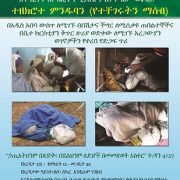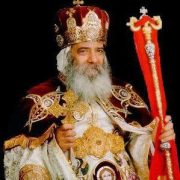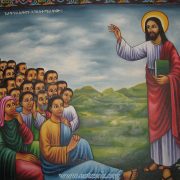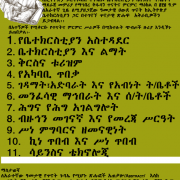A Burning Heaven in This World – Mt. Zeqwala Monastery
 The area of Mt. Zeqwala is a product of intense volcanic activity during a quaternary period. The cooling age produced a well preserved cone structure form of the volcanic eruption. The vent formed after the cooling of the eruption was filled by rain to become a huge crater lake. Written Church sources came to mention the place after the coming of his holiness Abune Gebre Menfes Kidus and his founding of the monastery that is still dedicated to him in 1168 Ethiopian calendar. However, the story of a church built by King Gebre Meskel and St. Yared on the mountain which vanished miraculously is told by the local monks. (read more)
The area of Mt. Zeqwala is a product of intense volcanic activity during a quaternary period. The cooling age produced a well preserved cone structure form of the volcanic eruption. The vent formed after the cooling of the eruption was filled by rain to become a huge crater lake. Written Church sources came to mention the place after the coming of his holiness Abune Gebre Menfes Kidus and his founding of the monastery that is still dedicated to him in 1168 Ethiopian calendar. However, the story of a church built by King Gebre Meskel and St. Yared on the mountain which vanished miraculously is told by the local monks. (read more)
 St. Gebre Menfes Kidus lived on the mountain for 262 years after establishing his Monastery. It is said that the saint lived on the place right up to his death in the 15th century. After that the then king of Ethiopia called Endreyas [Hisbe Nagn], built five churches (for St. Michael, for Saint Gabriel, for Holy Mary, for Savior of the world and the last for Abune Gebre Menfes Kidus) on and around the mountain in honor of the saint. These churches continued giving function up to the time of ‘Ahmed the left handed’ who destroyed it in the 16th century. Then Zeqwala and the famous monastery became a ruin for more than 400 years. After that a saintly saint anchorite and monk reached the place in the grace of the Holy Spirit and asked the Showa king Sahile Selassie to build a church on top of the mountain. The king sent soldiers who fought against the lions and bores which populated the place and cleared enough space to build a church. The place was made an important traditional worship site of the Oromo late in the 19th century during the founding of the Monastery once again by a saintly monk by the name Aba Gebre Hiwot. Even today a visitor might encounter these traditional worshipers on the mountain. St. Abo is said to have told a monk that such people will inherit the depth of hell for not believing in Christ seeing the wonders he has done and is doing on the monastery.
St. Gebre Menfes Kidus lived on the mountain for 262 years after establishing his Monastery. It is said that the saint lived on the place right up to his death in the 15th century. After that the then king of Ethiopia called Endreyas [Hisbe Nagn], built five churches (for St. Michael, for Saint Gabriel, for Holy Mary, for Savior of the world and the last for Abune Gebre Menfes Kidus) on and around the mountain in honor of the saint. These churches continued giving function up to the time of ‘Ahmed the left handed’ who destroyed it in the 16th century. Then Zeqwala and the famous monastery became a ruin for more than 400 years. After that a saintly saint anchorite and monk reached the place in the grace of the Holy Spirit and asked the Showa king Sahile Selassie to build a church on top of the mountain. The king sent soldiers who fought against the lions and bores which populated the place and cleared enough space to build a church. The place was made an important traditional worship site of the Oromo late in the 19th century during the founding of the Monastery once again by a saintly monk by the name Aba Gebre Hiwot. Even today a visitor might encounter these traditional worshipers on the mountain. St. Abo is said to have told a monk that such people will inherit the depth of hell for not believing in Christ seeing the wonders he has done and is doing on the monastery.The well preserved and intact nature of the mountain natural forest, Crater Lake, wild life be it mammals or birds is still remembered by the elders up to the beginning of the second half of the 20th century. The reverse began to happen with the land proclamation of 1966 E.C. This policy has its own effect at the local level by creating a power vacuum in the area. As a result with the reigning of chaos the forest on whole area was destroyed. To make matters worse Lutheran Mission was established on the area in 1989 E.C. and converted most of the farming society into Protestants with a deep hostility to the monastery. The so called ‘aid and development’ it planned to do was limited only with a modern headquarters and a huge seedlings of Eucalyptus yearly given to the peasant for free. Thus, the crippled, dependant and perverted peasants (those living at the surrounding lands away from Wanber kebele in most cases) still lead a life of poverty and apathy burning the forest now and then evil for themselves and others with no hope for a better tomorrow.
Today, the extremely dedicated monks in the likeliness of their father Abune Gebre Menfes kidus protect the forest from the surrounding people on and around Zeqwala thirsting for water during the summer months and shivering for warmth in the winter. Therefore, the Children of the EOTC must pay for pipe system to bring water to the place from the town at the base, build a modern hall for the priests and assist them to start apiculture. Helping them to build an all weather gravel road from Dire to the mountain is another area open for the kind laity seeking the blessing of Abune Gere Menfes Kidus. Therefore, all the laity and priests of the Ethiopian Orthodox Church are called to save this wonderful and national heritage from destruction. May the blessing of our God Christ rest on Yuhanis of Debre Wifat the writer of this hagiography in the 15th Century hearing it told from the holy Gebre Menfes Kidus himself and all of us who love the saint.
Amen!

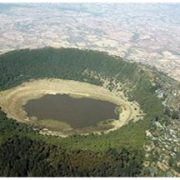
 አልነበረም፡፡ በቅጽሩ ጥግ ለጥግ ያረጁ የመካነ መቃብር ሐውልቶች ይታያሉ፡፡ በቤተ ክርስቲያኗ ፊት ለፊት በስተቀኝ በኩል ፈንጠር ብለው በክብር የተሠሩ አጥራቸው የተከበረ የቄስ ገብረ ኤዎስጣቴዎስ ዘመስቀል /1865-1905/፣ የአቶ ዳንኤል ዲባባ /1966-1904/ እና የአቶ ገብረ ኢየሱስ ተስፋዬ /12877-1925ዓ.ም./ መካነ መቃብር ይታያል፡፡ እነዚህ ሐውልቶች ለኘሮቴስታንት ቤተ ክርስቲያን ባለ ውለታ ለሆኑት ሦስት ግለሰቦች ለመታሰቢያ እንዲሆን የተሠራ ሐውልት እንደሆነ ነዋሪዎች አጫውተውናል፡፡ በተለይ ከሦስቱ ሰዎች አንዱ ቄስ ገብረ ኤዎስጣቴዎስ በርካታ ካሕናትን አስኮብልሎ የእኛ ቤተ ክርቲያን እንድትዘጋ ስላደረገ ኘሮቴስታንቱ ስሙን ይዘክሩታል፡፡ በዚች ጠባብ ከተማ 130 ዓመታት ያስቆጠረች የእመቤታችን የቅድስት ድንግል ማርያም ቤተክርስቲያን ትገኛለች፡፡ በከተማዋ ያደረግነው ቆይታ ከሀገረ ስብከቱ ስራ አስኪያጅ ከመጋቤ ሀዲስ ሀዲስ ዓለማየሁ እና ከወረዳው ቤተ ክህነት ሊቀ ካህናት ምሥጢሩ ዘለቀ ጋር ነበርን፡፡
አልነበረም፡፡ በቅጽሩ ጥግ ለጥግ ያረጁ የመካነ መቃብር ሐውልቶች ይታያሉ፡፡ በቤተ ክርስቲያኗ ፊት ለፊት በስተቀኝ በኩል ፈንጠር ብለው በክብር የተሠሩ አጥራቸው የተከበረ የቄስ ገብረ ኤዎስጣቴዎስ ዘመስቀል /1865-1905/፣ የአቶ ዳንኤል ዲባባ /1966-1904/ እና የአቶ ገብረ ኢየሱስ ተስፋዬ /12877-1925ዓ.ም./ መካነ መቃብር ይታያል፡፡ እነዚህ ሐውልቶች ለኘሮቴስታንት ቤተ ክርስቲያን ባለ ውለታ ለሆኑት ሦስት ግለሰቦች ለመታሰቢያ እንዲሆን የተሠራ ሐውልት እንደሆነ ነዋሪዎች አጫውተውናል፡፡ በተለይ ከሦስቱ ሰዎች አንዱ ቄስ ገብረ ኤዎስጣቴዎስ በርካታ ካሕናትን አስኮብልሎ የእኛ ቤተ ክርቲያን እንድትዘጋ ስላደረገ ኘሮቴስታንቱ ስሙን ይዘክሩታል፡፡ በዚች ጠባብ ከተማ 130 ዓመታት ያስቆጠረች የእመቤታችን የቅድስት ድንግል ማርያም ቤተክርስቲያን ትገኛለች፡፡ በከተማዋ ያደረግነው ቆይታ ከሀገረ ስብከቱ ስራ አስኪያጅ ከመጋቤ ሀዲስ ሀዲስ ዓለማየሁ እና ከወረዳው ቤተ ክህነት ሊቀ ካህናት ምሥጢሩ ዘለቀ ጋር ነበርን፡፡ ሊቀ ካህናት ምሥጢሩ ስለ ቦጂ ቅድስት ማርያም ቤተክርስቲያን ታሪክ በአጭሩ ነግረውናል፡፡ እኛም እድሜ ጠገብነቷ አስደምሞን ልቡናችን በቤተ ክርስቲያኗ ታሪክ መዋለል ዓይኖቻችን በሕንፃዋ መንቀዋለል ጀመሩ፡፡ ከወፍ ድምጽ በቀር ምንም የማይሰማባት ቤተ ክርስቲያን ናት ማህሌቱ፣ቅዳሴው፣ጸሎተ እጣኑ ከተቋረጠ ዓመታት ተቆጥረዋል፡፡ ይህቺ ደብር የወላድ መካን የሆነች ካሕናቷ በኘሮቴስታንት ሰባኪያን የተወሰዱባት ቤተ ክርቲያን ናት፡፡ በልጆቿ መጥፋት ያዘነችው ቦጂ ቅድስት ማርያም ልጆቼን! እያለች ትጮኸለች፡፡
ሊቀ ካህናት ምሥጢሩ ስለ ቦጂ ቅድስት ማርያም ቤተክርስቲያን ታሪክ በአጭሩ ነግረውናል፡፡ እኛም እድሜ ጠገብነቷ አስደምሞን ልቡናችን በቤተ ክርስቲያኗ ታሪክ መዋለል ዓይኖቻችን በሕንፃዋ መንቀዋለል ጀመሩ፡፡ ከወፍ ድምጽ በቀር ምንም የማይሰማባት ቤተ ክርስቲያን ናት ማህሌቱ፣ቅዳሴው፣ጸሎተ እጣኑ ከተቋረጠ ዓመታት ተቆጥረዋል፡፡ ይህቺ ደብር የወላድ መካን የሆነች ካሕናቷ በኘሮቴስታንት ሰባኪያን የተወሰዱባት ቤተ ክርቲያን ናት፡፡ በልጆቿ መጥፋት ያዘነችው ቦጂ ቅድስት ማርያም ልጆቼን! እያለች ትጮኸለች፡፡ የመንግሥት ሥራ ጋር አጣጥሞ አገልግሎቱን አጠናክሮ መቀጠል እንዳልቻለ ገልጦልናል፡፡ የከተማዋ ነዋሪዎችም ሥራ ለማግኘትና በኘሮጀክት ታቅፈው የእለት ኑሮአቸውን ለመግፋት ሳይወዱ በግድ ወደ ኘሮቴስታንት እምነት ለመሔድ እንደሚገደዱ ነዋሪዎች ይገልጣሉ፡፡
የመንግሥት ሥራ ጋር አጣጥሞ አገልግሎቱን አጠናክሮ መቀጠል እንዳልቻለ ገልጦልናል፡፡ የከተማዋ ነዋሪዎችም ሥራ ለማግኘትና በኘሮጀክት ታቅፈው የእለት ኑሮአቸውን ለመግፋት ሳይወዱ በግድ ወደ ኘሮቴስታንት እምነት ለመሔድ እንደሚገደዱ ነዋሪዎች ይገልጣሉ፡፡ ቦጂ ቅድስት ማርያም ጥንታዊት ቤተ ክርስቲያን ናት፡፡ ያጣቻቸውን ልጆች መልሳ ለማግኝት በሯን ከፍታ ትጠብቃለች፤ ተከታታይ ጉባዔያት ቢካሔዱ በአፍ መፍቻ ቋንቋቸው የሚያስተምራቸው ሰባኬ ወንጌል ቢመደብላቸው የጠፉት ነፍሳት ሊመለሱ እንደሚችሉ ምእመናን በመሉ ተስፋ ይናገራሉ፡፡ እኛም ታሪክ ተቀይሮ መናፍቃኑ መሠረት ከጣሉበት ቦታ አንድ ለውጥ ይመጣ ይሆን? የሚለውን ጥያቄ በውስጣችን ይዘን ተመልሰናል ሕንጻ ቤተ ክርስቲያንን ከመገንባት ሕንጻ እግዚአብሔር ሰውን ማነጽ ይበልጣል፡፡ የጠፉት በጐች ወደ በረታቻው ካልተመለሱ እዳው የቤተክርስቲያን መሆኑ አያጠያይቅም ስለዚህ ባለ ድርሻ አካላት የምንችለውን ሁሉ እንድናደርግ ቦጂ ትጮሀለች፡፡
ቦጂ ቅድስት ማርያም ጥንታዊት ቤተ ክርስቲያን ናት፡፡ ያጣቻቸውን ልጆች መልሳ ለማግኝት በሯን ከፍታ ትጠብቃለች፤ ተከታታይ ጉባዔያት ቢካሔዱ በአፍ መፍቻ ቋንቋቸው የሚያስተምራቸው ሰባኬ ወንጌል ቢመደብላቸው የጠፉት ነፍሳት ሊመለሱ እንደሚችሉ ምእመናን በመሉ ተስፋ ይናገራሉ፡፡ እኛም ታሪክ ተቀይሮ መናፍቃኑ መሠረት ከጣሉበት ቦታ አንድ ለውጥ ይመጣ ይሆን? የሚለውን ጥያቄ በውስጣችን ይዘን ተመልሰናል ሕንጻ ቤተ ክርስቲያንን ከመገንባት ሕንጻ እግዚአብሔር ሰውን ማነጽ ይበልጣል፡፡ የጠፉት በጐች ወደ በረታቻው ካልተመለሱ እዳው የቤተክርስቲያን መሆኑ አያጠያይቅም ስለዚህ ባለ ድርሻ አካላት የምንችለውን ሁሉ እንድናደርግ ቦጂ ትጮሀለች፡፡